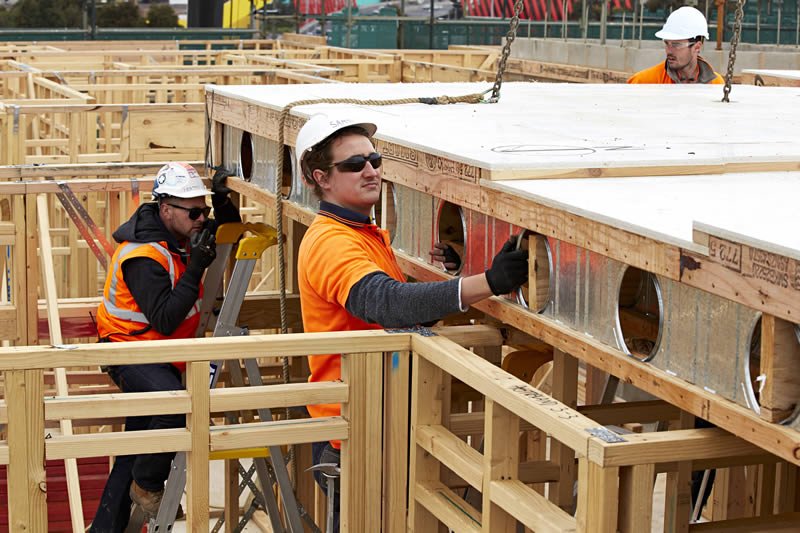The list of experts taking the stage at Frame Australia 2018 ‘Timber Offsite Construction’ continues to grow.
For anyone working in the frame and truss, construction, engineered timbers and associated software and machinery sectors, now is the time to organise your travel to include Frame Australia 2018 ‘Timber Offsite Construction’ conference and exhibition in your plans. Scheduled for Monday and Tuesday 18-19 June at Park Hyatt Melbourne, the conference brings together some of the best names in the business, as well as a raft of suppliers who will be displaying and educating users about their products.
SmartStruct timber building solutions firm has come on board as Principal Partner of Frame 2018. The team designs with engineered wood products and will be presenting their product and service ranges to conference goers.
The event speakers fall into several major categories. Below is a small taste of some of the session highlights.
For booking and more details, visit www.frameaustralia.com.
BUILDING DESIGN
Nick Milestone of William Hare Group International, UK, will be speaking on ‘Disruption through prefabrication – the evolution and future of mass timber’.
Synopsis: Due to the lightweight capability and the advancement of post-processed technology of both CLT and mass timber, when combined with BIM (Building Information Modelling) and manufacturing technologies, we now have the ability to adapt and create new building systems. These include 2D structural/load bearing through-wall, roof components and 3D volumetric systems. Mass timber is becoming a more frequently used solution when combined with traditional materials that can result in low carbon, energy efficient buildings that can be constructed quicker, lighter and cheaper than conventional building designs.
The speaker: Milestone is an associate director at William Hare Group and current Chairman of TRADA, the UK-based Timber Research and Development Association. Armed with several degrees from Leeds Beckett University, including an MSc in Project Management specialising in construction planning and economics, he is a passionate advocate for timber in construction. Alongside his work promoting the industry and educating practitioners on new and emerging technologies, Nick has decades of practical experience in major builds.
Jochen Ristig, technical director – building structures at AECOM, is presenting ‘Pushing the boundaries to achieve carbon-neutral, healthy communities’.
Synopsis: Monash University is embarking on what will be a landmark project in Australia: a 6-storey, 150-key student accommodation building on its Mornington Peninsula Campus. The project is aiming to radically reduce embodied and operating carbon through combining a cross-laminated timber structural system with Passive House performance. This presentation will highlight the tangible benefits of more sustainable methods of construction while striving to push the boundaries in realising a low-carbon future, with a focus on wellbeing and comfort for students.
The speaker: Shortly after completing his structural engineering qualifications at Germany’s TU Dortmund University, Ristig took up a position as senior structural engineer with multinational Hyder Consulting, followed by several roles in Melbourne before taking up his work at AECOM. He has more than 15 years’ experience in various multi-disciplinary leadership positions on projects in Australia, Germany, Singapore and the Middle East, including the Melbourne Park Redevelopment; Dubai Festival City; Siemens ‘Hochhaus’, Moscow; Living Office, Düsseldorf, Germany and the Marina Bay Sands Canopy, Singapore.
TECHNOLOGY
Perry Forsythe, Professor of Construction Management at the University of Technology Sydney, is discussing ‘Understanding the Map of Digital Technologies in Construction’.
Synopsis: Digital technologies are disrupting construction businesses en masse, but also providing innovation, business improvement and competitive advantage. For instance, BIM and fabrication modelling are creating improved information flows from design to file to factory to site. Digital data exchange and automation are being assisted by manufacturing concepts such as ‘Industry 4.0’. Visualisation is enhanced by Virtual Reality, Augmented Reality and Microsoft’s HoloLens technology.
Complementary technologies such as GPS and RFID technology provide added capability. This talk provides a mapping to make sense of it all, including how these pieces fit together, what they do and what they potentially mean to timber construction.
The speaker: Forsythe began his construction career as a carpenter and is a classic hands-on academic who brings enormous breadth of real-world understanding to issues, coupled with rigourous research in fields that include construction productivity, process improvement, supply chain integration, quality management, customer satisfaction, waste management, uptake of digital technologies and sustainability issues. His 1993 Churchill Fellowship saw Forsythe travel through the UK, Sweden and the Netherlands investigating good-quality, cost-effective housing, an interest that continues to resonate in his urban design work. Mass timber technologies are a natural development, given their efficiencies of production as well as environmental and social benefits, and Forsythe has been a keen promotor of them in his academic and industrial work, both in Australia and overseas.
Katie Fowden, manager strategic relations at Hyne Timber, has a project-based talk: ‘Engineered Timber Fire Station: A Collaborative Journey of Innovation’.
Synopsis: In June 2017, the Queensland Government agreed to consider the design of a new, engineered timber fire and rescue station and regional headquarters complex in Maryborough under the State’s Market-Led Proposal framework. The State has welcomed the proposal which is being led by Hyne Timber in partnership with the University of Queensland Centre for Future Timber Structures, Hutchinson Builders, XLam and Baber Studio. Scanning, 3D modelling, the first Australian glue laminated timber BIM content and topology optimisation are just a few items on the list of technology employed by the collective design team.
The speaker: Fowden’s background in social policy and criminology provided a forensic commitment to detail that has led to a successful career focusing on policy and communication. This ability to draw together stakeholders in pursuit of a common goal, based on well-researched and implemented planning, has found an ideal home at Hyne Timber. Having recently celebrated the centenary of Forest and Forestry Product Research in Queensland, Hyne Timber is a key partner with industry, government and academic research facilities, dedicated to growing forestry and timber manufacturing through sophisticated new approaches, with an emphasis on sustainability and long-term retention and growth of industry jobs through continuous innovation and adaptation to changing physical, market and regulatory environments.
MANUFACTURING
Martin Smith, managing director at Modular Building Automation, UK, asks ‘Can the use of modern data interfaces improve productivity in a prefabrication plant?’
Synopsis: A review of the way in which digital data is used in prefabrication plants at present, together with an overview of the latest innovations in this area. The talk will also touch on virtual reality and augmented reality and consider how these might be used in a real-world environment. In addition, we will consider the ways in which the digital path can be shortened, to streamline the flow of data both to and from the plant.
The speaker: Smith’s Modular Building Automation (MBA) is an offshoot of JJ Smith & Co, a family company that has been at the forefront of industrial woodworking machinery for over 90 years, working with H&M Houtbewerkingsmachines of Sneek, Netherlands. Since 2005, Martin Smith has been driving MBA, promoting automated equipment for the offsite industry and timber frame sector. Smith’s work is particularly focused on optimisation and offsite construction process flows, and he combines many years of practical experience with a comprehensive understanding of both the tools available and the processes involved – including potential stumbling points – particularly for new start-up timber frame production facilities. This is a return to Frame Australia for Smith after his well-received 2016 presentation.
CONSTRUCTION
Andrew Dunn, CEO of the Timber Development Association is presenting on ‘Global markets and cost comparison for tall timber buildings’.
Synopsis: Building types and activity levels for construction of tall timber buildings in North America and Europe, with comparison to the Australian timber frame and mass timber construction market now emerging. Summary of building projects currently being planned or under construction around Australia with cost comparisons for both local and global developments in multi-residential and commercial buildings.
The speaker: Committed to the Timber Development Association’s goal of technical advancement in the timber industry, Dunn combines decades of experience in the timber building industry with a comprehensive understanding of Australian Standards, representing the industry in the AS development on topics ranging from timber framing, bushfire and termite control to design loads and earth retaining structures. He has been a key figure in the introduction of cross laminated timber and mid-rise timber building systems in Australia. Like many of the most influential voices in timber, he combines a strong academic side – a Civil/Structural Engineering degree from the University of Sydney and a Masters of Timber Engineering from Central Queensland University – with a practical understanding of the material and its uses, down to the need to inform, educate and inspire consumers.
Philipp Zumbrunnen, director of Eurban Ltd in the UK, will speak on ‘Delivering mass timber projects – Integrated design the way to success’.
Synopsis: The concept of integrated design, from an architectural concept to delivering a mass timber structure on site, looks at a building from many different aspects and from start to finish. Designing mass timber buildings needs a strong view on fabrication and installation from the start, and a close relationship with the supplier and installers will save money and time. Example projects will show how we deliver buildings and our thinking behind delivering mass timber structures with an integrated design approach for 15 years demonstrated in nearly 300 projects
The speaker: Training first as a carpenter and then foreman, Swiss-born Zumbrunnen’s passion for timber construction was consolidated during his time as a Project Manager for a Zurich-based architectural office specialising in timber buildings. This led to the Bern University of Applied Sciences, Architecture, Wood & Civil Engineering, where Zumbrunnen qualified as a timber Structural Engineer in 2007. This specialisation has seen him work extensively in delivering CLT structures in the UK with an emphasis on matching architectural design to construction system and managing fully integrated production processes. Almost as important as his work in physically driving the success of CLT in taller structures has been his advocacy of the material and its uses within the broader building sector, with presentations at events around the world.












